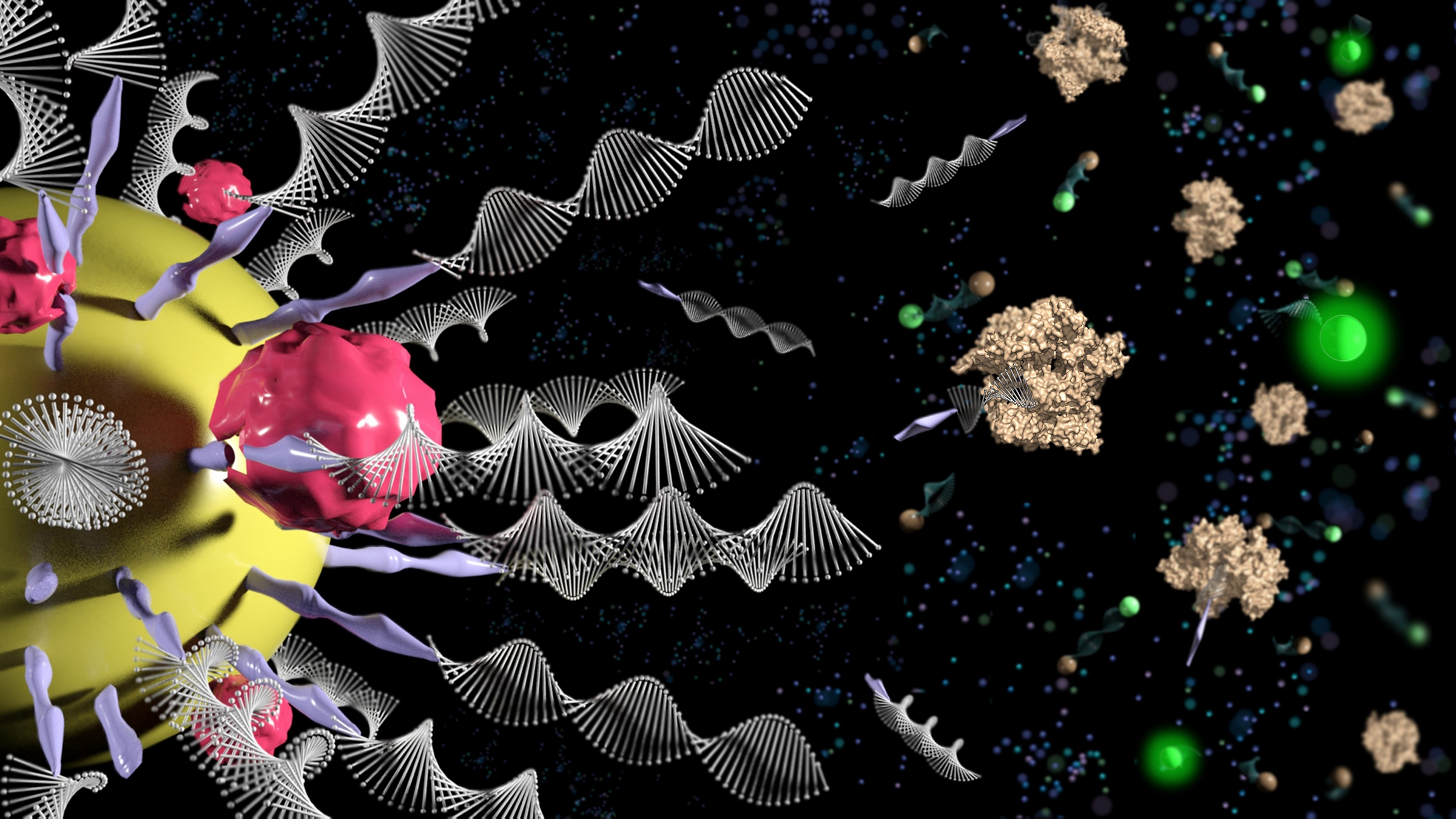New Sensors Could Detect Cancer and Other Diseases Earlier and More Precisely
Devleena Samanta led a team to develop a new kind of sensor that can be used to find unique fingerprints of cancers, infections and neurodegenerative diseases.

DNA-barcoded plasmonic nanostructures enable the detection of disease-relevant proteases with 100-fold improved sensitivity compared to existing methods. Image credit: Seungheon Lee.
Protein-splitting enzymes, called proteases, play an important role in many physiological processes. For example, when we eat, proteases in our stomach help break down the proteins in our food. When proteases misbehave, it can be an early sign of a disorder such as cancer, an infection or a neurodegenerative disease. Researchers from The University of Texas at Austin have developed a new class of protease-activity sensors that could enable earlier and more precise detection of these diseases than with existing diagnostics.
Proteases are generally present in an inactive state, only becoming activated when the body needs them. Current methods of detecting active proteases are limited in terms of sensitivity, making it difficult to detect them with low activities. Additionally, a single protease may be involved in multiple diseases. Therefore, by detecting a single protease, it is not possible to know for sure what disease a person has.
In the journal Angewandte Chemie, UT researchers describe a new class of protease-activity sensors: gold nanoparticles equipped with peptides and DNA.
“We are excited because our probes are 100-fold more sensitive compared to existing commercial fluorescence-based probes and they work in complex biological samples such as serum,” said Devleena Samanta, an assistant professor in the Department of Chemistry. “Moreover, these probes can be used to detect multiple proteases simultaneously.”
Also, virtually any protease can be detected if the peptide it splits is known. Taken together, these nanoprobes can potentially enable early disease detection and improve the precision and reliability of diagnostic tests.
The team was led by Samanta and Anna Capasso, medical director of the Clinical Trials Office and assistant professor of oncology at UT’s Dell Medical School.
The team demonstrated the high sensitivity and selectivity of their new method using two markers for active COVID-19 infections (3CL and caspase3). The clinical potential of this test was also demonstrated by the detection of cathepsin B, a protease related to colorectal cancer, in three different tumor cell lines obtained from patients.
At the core of the novel probes are gold nanoparticles equipped with chains made of a peptide and a DNA fragment. The peptide structure is designed to be one that is split by the protease being detected. The DNA acts as a unique barcode for identifying the peptide and also amplifies the signal. If the desired protease is present in its active form in the sample, the peptide splits it. This releases the DNA barcode into the solution, where it can be detected with fluorescent molecules that glow brightly with specific colors based on the DNA sequence.
The sensors can also be read in a second way. If no instruments are available on site and the test must go fast, detection is also possible with the naked eye: if the protease splits the peptide on the probe, the surface charge of the gold nanoparticles changes and they clump together. The color of these so-called “plasmonic nanostructures” depends significantly on their degree of aggregation. Although the sensitivity is somewhat lower, these changes can be detected by the naked eye at room temperature without any complicated instrumentation.
“Therefore, these probes could be potentially used for disease diagnostics in resource-limited settings,” Samanta said.
Samanta noted that the ability to detect multiple active proteases simultaneously (a.k.a. multiplexed detection) will enable them to obtain "protease activity profiles," which they expect will be unique for each particular disease, just like a fingerprint.
“Our ultimate goal is to develop these protease activity profiles using these highly sensitive probes,” Samanta said. “We envision that we can use these probes and the protease activity profiles to build diagnostic platforms for detecting diseases such as cancer, infectious diseases and Alzheimer's based on simple, non-invasive tests; for example, using blood.”
Samanta conceived of the research project and co-designed the experiments. First author Subrata Pandit carried out all the experiments and also helped to design experiments. Capasso oversaw the research related to patient-derived colorectal cancer cells.
Adapted from a press release by the journal Angewandte Chemie.


